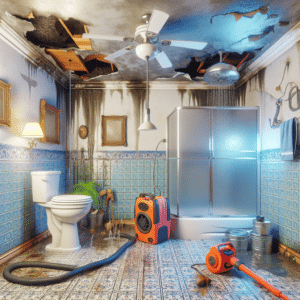Mold is a multi-tasking troublemaker. It looks gross, smells bad, and can cause a variety of health issues that range from mildly irritating (watery eyes and runny nose) to deadly serious (asthma and chest tightness). If all of that wasn’t bad enough, a little bit of mold goes a long way. Mold needs many things to thrive (moisture, dust, lack of sunlight to name just a few of the contributing factors) – and households and businesses offer plenty of those elements. An effective mold removal method has to take all of these factors into account to not only stop the spread of mold – but to make sure it does not return. Here’s how we rid houses and businesses of mold.
Testing For Mold
Much like our water cleanup process, our mold removal process takes a scientific approach. Our first step is to run some tests to determine if your property does, in fact, have mold. We’ll run tests on the air and surface area and send those samples to an independent laboratory that specializes in mold cases. It usually takes about three business days to receive the results. Once we receive the test results, our experts will analyze them and provide us with a detailed report. If the results are negative, then your property doesn’t have a mold infestation and you can safely enjoy your home or office. If the results are positive, there’s no need to panic. Our mold removal experts will proceed with the next phase of our process for removing mold.
Locating Mold
Now that we know that your property has mold, we have to find out where it’s hiding. As good as our eyes and noses are, we don’t solely rely on our senses of sight and smell. Mold grows in damp areas that lack sunlight – and those areas are tough to find. Once again, we take the scientific approach to finding mold. A combination of thermal cameras and moisture meters helps us locate the source of mold and where it may be spreading. Now that we know where the mold likes to hide, we can determine the extent of your property’s mold infestation and begin the process of mold removal.
Removing Mold
Now that we know where the mold is located, the next thing we want to do is make sure it doesn’t continue to spread. We’ll contain the mold-infected area and, using a series of HEPA (high-efficiency particulate air) filters, subject that area to negative air pressure. This method prevents any airborne mold spores from leaving the containment area and spreading to currently unaffected parts of your property. Next, we’ll remove or treat the contaminated area depending on the severity of mold infestation.
Our next step in the process is to make the mold powerless through encapsulation. We do this with a specialized paint/sealant that traps the mold and prevents it from releasing any more spores. After all of those steps have been completed, we paint the surfaces and patch them if necessary.
Finishing Up
Before we can call the mold removal process complete, we need to take one final test to ensure that we have rid your property of any excess mold. Once we get the all-clear sign from the lab, you can rest easy knowing that your property is now mold-free.
New Jersey prides itself on being the Garden State. Our crops grow great but unfortunately so does mold. Many of our famous neighborhoods like Jersey City and Hoboken are commonly subject to mold issues. Luckily, our mold removal experts at FloodCo USA are here to rid New Jersey of mold using a process that follows recommended EPA and IICRC guidelines.
Contact us today to learn more about our mold remediation and removal processes.



